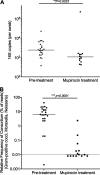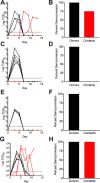Respiratory Bacteria Stabilize and Promote Airborne Transmission of Influenza A Virus
- PMID: 32873612
- PMCID: PMC7470989
- DOI: 10.1128/mSystems.00762-20
Respiratory Bacteria Stabilize and Promote Airborne Transmission of Influenza A Virus
Abstract
Influenza A virus (IAV) is a major pathogen of the human respiratory tract, where the virus coexists and interacts with bacterial populations comprising the respiratory tract microbiome. Synergies between IAV and respiratory bacterial pathogens promote enhanced inflammation and disease burden that exacerbate morbidity and mortality. We demonstrate that direct interactions between IAV and encapsulated bacteria commonly found in the respiratory tract promote environmental stability and infectivity of IAV. Antibiotic-mediated depletion of the respiratory bacterial flora abrogated IAV transmission in ferret models, indicating that these virus-bacterium interactions are operative for airborne transmission of IAV. Restoring IAV airborne transmission in antibiotic-treated ferrets by coinfection with Streptococcus pneumoniae confirmed a role for specific members of the bacterial respiratory community in promoting IAV transmission. These results implicate a role for the bacterial respiratory flora in promoting airborne transmission of IAV.IMPORTANCE Infection with influenza A virus (IAV), especially when complicated with a secondary bacterial infection, is a leading cause of global mortality and morbidity. Gaining a greater understanding of the transmission dynamics of IAV is important during seasonal IAV epidemics and in the event of a pandemic. Direct bacterium-virus interactions are a recently appreciated aspect of infectious disease biology. Direct interactions between IAV and specific bacterial species of the human upper respiratory tract were found to promote the stability and infectivity of IAV during desiccation stress. Viral environmental stability is an important aspect during transmission, suggesting a potential role for bacterial respiratory communities in IAV transmission. Airborne transmission of IAV was abrogated upon depletion of nasal bacterial flora with topical antibiotics. This defect could be functionally complemented by S. pneumoniae coinfection. These data suggest that bacterial coinfection may be an underappreciated aspect of IAV transmission dynamics.
Keywords: Streptococcus pneumoniae; microbiome; transmission.
Copyright © 2020 Rowe et al.
Figures



Similar articles
-
Cysteinyl Maresins Reprogram Macrophages to Protect Mice from Streptococcus pneumoniae after Influenza A Virus Infection.mBio. 2022 Aug 30;13(4):e0126722. doi: 10.1128/mbio.01267-22. Epub 2022 Aug 1. mBio. 2022. PMID: 35913160 Free PMC article.
-
Secondary streptococcal infection following influenza.Microbiol Immunol. 2022 Jun;66(6):253-263. doi: 10.1111/1348-0421.12965. Epub 2022 May 26. Microbiol Immunol. 2022. PMID: 35088451 Review.
-
Stability of influenza A virus in droplets and aerosols is heightened by the presence of commensal respiratory bacteria.J Virol. 2024 Jul 23;98(7):e0040924. doi: 10.1128/jvi.00409-24. Epub 2024 Jun 13. J Virol. 2024. PMID: 38869284 Free PMC article.
-
Aerosol Transmission from Infected Swine to Ferrets of an H3N2 Virus Collected from an Agricultural Fair and Associated with Human Variant Infections.J Virol. 2020 Jul 30;94(16):e01009-20. doi: 10.1128/JVI.01009-20. Print 2020 Jul 30. J Virol. 2020. PMID: 32522849 Free PMC article.
-
Modeling Influenza Virus Infection: A Roadmap for Influenza Research.Viruses. 2015 Oct 12;7(10):5274-304. doi: 10.3390/v7102875. Viruses. 2015. PMID: 26473911 Free PMC article. Review.
Cited by
-
Polymicrobial Interactions Operative during Pathogen Transmission.mBio. 2021 May 18;12(3):e01027-21. doi: 10.1128/mBio.01027-21. mBio. 2021. PMID: 34006664 Free PMC article. Review.
-
Transkingdom Interactions Important for the Pathogenesis of Human Viruses.J Infect Dis. 2021 Jun 16;223(12 Suppl 2):S201-S208. doi: 10.1093/infdis/jiaa735. J Infect Dis. 2021. PMID: 33330907 Free PMC article.
-
Rethinking next-generation vaccines for coronaviruses, influenzaviruses, and other respiratory viruses.Cell Host Microbe. 2023 Jan 11;31(1):146-157. doi: 10.1016/j.chom.2022.11.016. Cell Host Microbe. 2023. PMID: 36634620 Free PMC article. Review.
-
Detection of influenza virus and Streptococcus pneumoniae in air sampled from co-infected ferrets and analysis of their influence on pathogen stability.mSphere. 2023 Aug 24;8(4):e0003923. doi: 10.1128/msphere.00039-23. Epub 2023 May 31. mSphere. 2023. PMID: 37255295 Free PMC article.
-
A Murine Model for Enhancement of Streptococcus pneumoniae Pathogenicity upon Viral Infection and Advanced Age.Infect Immun. 2021 Jul 15;89(8):e0047120. doi: 10.1128/IAI.00471-20. Epub 2021 Jul 15. Infect Immun. 2021. PMID: 34031128 Free PMC article.
References
Grants and funding
LinkOut - more resources
Full Text Sources
